Travel Column: Up and Away, Down to Earth—Varanasi, India
Posted by Stephanie Weyant
Dear Friends,
Happy spring! Welcome to the final installment of my adventures through India. This is my Return of the King of the India articles, a double edition as I roll into Varanasi, one of the seven holiest places of the Hindu faith. Next month on May 14th, I will bring you another double edition of advice and crucial tips if you do venture to India, and as always, feel free to e-mail me any questions you may have!
While this could have been three more months of publications, I want to share with you new places. Stay tuned the following month – on June 11th, I’ll be staying a bit closer to home as I visit Bean Town: a weekend away to see the spirit and history of Boston, Massachusetts.
So sit back, relax, and grab a couple glasses of wine, because you might be here for a while. But I hope you revel in the story like I did – there are cries, laughter, enemies, and friends. The experience was as rich and colorful as the saris the women wore. Enjoy!
Sincerely,
Stephanie
* * *
The Story of India: Part III
By: Stephanie Weyant
* * *
The light fades, and night takes over. It is quiet. I sit with Chloë at our hotel in Agra, biding our time until our train to Varanasi departs. A crack of thunder breaks the silence, and I wonder if the storm from earlier has returned.
There are two computers in the lobby that let us check our e-mails and reconnect with the world; since my arrival here, there has been no Google, no Facebook, no phone calls, and very few texts – technology that I can’t say I’ve missed, though the people it connects me to, I have. Just as I type my last e-mail and begin to depend upon electronics again, the power shuts off. Another blackout.
Chloë turns to me. “I guess that was that.”
A common occurrence in India, the locals are used to losing power. The hotel’s candles come out quickly, and soon an ambiance that I never could have pictured surrounds me. I’m quite content and don’t want to leave, but it’s time.
We step outside for a rickshaw and soon we are bumbling along toward the train. I quickly realize that all of town is without power, and all of the shops are operating via candlelight, obscuring the ugliness and the trash. The ride is almost enchanting. Gypsy-like. Spiced meats cooking over open fire blend with the heavy scent of rain, and I feel the air’s moisture on my skin as we breeze down the path. It’s like we’re peeking into an ancient world that’s arousing all of our senses. Here, the rain washed away the power – and the dirt, the heat, and the insects along with it.
At the train station, we wait for our 9:20pm departure for Varanasi. I have no idea what to expect, but after the bus ride days before, I’m expecting the worst. The train pulls up, and I witness an organized chaos that somehow seems to work. There are cars labeled with the class of service; the cabin cars seem civilized while the lower class cars have people dangling out the sides. What would petrify me leaves those hanging on unfazed – just a part of getting from city to city.
We board a Class 4 car – it’s a sleeper train, typical of many Indian trains – where there are endless rows of narrow bunks two and three bunks high. A ladder gets you up to the top, and there’s enough room to sit up. We have an upper and a lower near the door, and when we locate our assigned spot, there are two greasy men lounging on them. Awesome. Chloë to the rescue – and familiar with this scenario – boots them out with ease. She gives me the upper; it’s better, she says. Shortly thereafter, as she has warned me about, an old and icky man in rags plunks down on her bunk – with her on it.
She looks at him point blank and says, “You need to leave.” He does. Then he shuffles three feet to the bunk area of another family and plops down on their bunk next to a child. Like Chloë, the Indian man tells him he needs to get up, though with a bit more hostility. The old man grumbles, but moves. So that’s how it’s done! Noted.
We settle into our spots while the train departs. As I look around, I realize how happy I am. Chloë’s head pops out from the bunk. “Not bad, right?” Agreed! “No, not at all!” I’m perched up high, my bags are protected inside between myself and the car, there aren’t many bugs, and I have my own space. Not to mention this 12-hour train journey taking us west to east across India cost us each 490 rupees, or about $10.
I should sleep, but instead I write. It’s peaceful. Chloë and others around me begin to fade, falling asleep as the train chugs along the tracks. A light breeze from the open windows keeps me cool, and as I stay awake writing I feel I’ve just stolen a moment for myself. The rhythmic sound of metal wheels barreling through the night is soothing, the same way a car ride can rock a child to sleep.
Two young girls in the upper berths across from my bunk steal glances at me, hiding giggles. We keep exchanging smiles. I can finally show that vulnerable side. In the streets it’s hard to do because it invites so much attention, but on the train, they’re not looking for money or to sell me something. They’re just on their way somewhere too.
It isn’t long into our journey that I notice the same three children walk past me for the third time. Two Indian girls and their kid brother are itching to say something. Finally they stop, and the younger girl nudges the older one to speak. And I feel as though I now know what it’s like to be famous. Smiling, she asks my name. I tell her, and then ask hers. She asks me, “Can we have our picture taken with you?” Flattered in spite of myself, I can’t help but feel that this is the most adorable thing I’ve ever experienced. I happily agree to this harmless little request, and hop off the bunk to meet them.
As I hit the ground, the train comes to a stop, and the kids want to step off the train for the photo. Noooo… “I can’t do that, but we can stay on the train.” They hand their camera to one of the passengers standing near the open doorway between cars. He takes two, just in case. The kids smile, shy once again, and scurry off. It wasn’t the first time I’d been asked to take a photograph with someone – boys and men had asked in both Delhi and Agra, and frequently people took our picture without asking at all – but this was the first time I obliged.
With that little moment, I hop back up on my bunk and lie down to sleep. A couple of times, I stir and tuck in tight, afraid I’ll fall off with the speed and the train rocking. But it’s calm, and so quiet. At times, you can hear and smell the rain outside: so fresh – with the breeze and rocking, I fall into a long, deep slumber.
* * *
I awake to see my “friends” across the bunks gone and for a second, quickly panic thinking I missed my stop and lost Chloë. Popping my head below, I see she’s there reading, and I breathe a sigh of relief. “Hey!” Chloë tells me about her night; it wasn’t quite the dream mine was. “I was so annoyed. This old woman comes up and sits down…on my legs. *ON* my legs! Nice wake up. It’s 6:00am. I look at her like, Really? …and nothing.” I ask, “What’d you say?” “I said, ‘you need to move.’” At this point, I decide to keep my awesome night’s sleep to myself. Chloë continues: “I wouldn’t have minded if she just sat near the edge, but ON me? Come on.”
The light of midmorning gives me a chance to see exactly what we’re passing. And stepping out to the large open doorway – one heavy sway of the train and you could fall out – I see the India that I’d long ago envisioned. Miles of lush, green fields tended by local farmers; a girl wearing a bright red sari walks steadily with a basket of produce on her head. Animals graze, and children wander. The bucolic images are best captured in my memory as the photos I take come out blurry. Contrary to most of India, on the train we are moving quickly.
Two hours later, we arrive in Varanasi. How to characterize Varanasi. Exotic, polluted, poor, and ancient, Mark Twain famously described Varanasi as “older than history, older than tradition, older even than legend, and looks twice as old as all of them put together.” But what sets Varanasi apart to me, sadly, likely results from the pollution and nearby water.
Imagine you are in the most humid place on earth, and imagine right behind you is a landfill. You have both sugar and meat in your hand, as well as cow dung and roadkill at your feet. Now imagine how many flies might be swarming around you in this scenario. That’s how many are here. The flies are inescapable; you reach a point where for your sanity’s sake, you can no longer swat them away. They land in your food, on your arms, on your face, on your bags…this is Varanasi.
It is a significant city for many reasons – historically, spiritually, and religiously – and traces back 3,000 years. As one of the seven sacred places for Hindus, this ancient city is believed to have been visited by Lord Shiva and his consort Parvati when time began ticking. Hindus believe that should they pass away in this city, they will be exalted from mortal sins and find eternal nirvana, ending the cycles of reincarnation. By bathing in the Ganges River, Hindus believe one cleanses the soul by washing away sin. Also known as Benares, it’s a place filled with temples and shrines, and famous for burning the dead in massive bonfires, visible and somewhat disturbing to anyone along the river.
Varanasi has endured through times of prosperity, oppression, cultural advances, and poverty. The days of the thriving Mughal empire have long since passed; today, it is estimated that 71% of the population is unemployed. Adding to a difficult economy, the romanticism of an historic city along a holy river is badly tarnished by the sobering pollution problem. It’s a grim reality that has manifested itself in the Ganges River which has been impacted most notoriously. Although people bathe and launder clothes in the river, the untreated runoff waste of many sewage plants, slaughterhouses, chemical plants, and hospitals all contribute to a staggering concentration of deadly bacteria in the water. Not only are the remains of human and animal corpses dumped in the Ganges, but human waste is a major problem as well. To put it in perspective, the maximum limits for what’s considered safe to swim or bathe in is a ratio of up to 500 fecal coliform and e. coli bacteria parts per every 100ml of water. According to Lonely Planet‘s very conservative estimates, per 100ml of water, the Ganges River contains 1,500,000 fecal coliform parts. Yes – the river that Hindus believe cleanses their body and soul exceeds toxicity guidelines by 3,000 times!
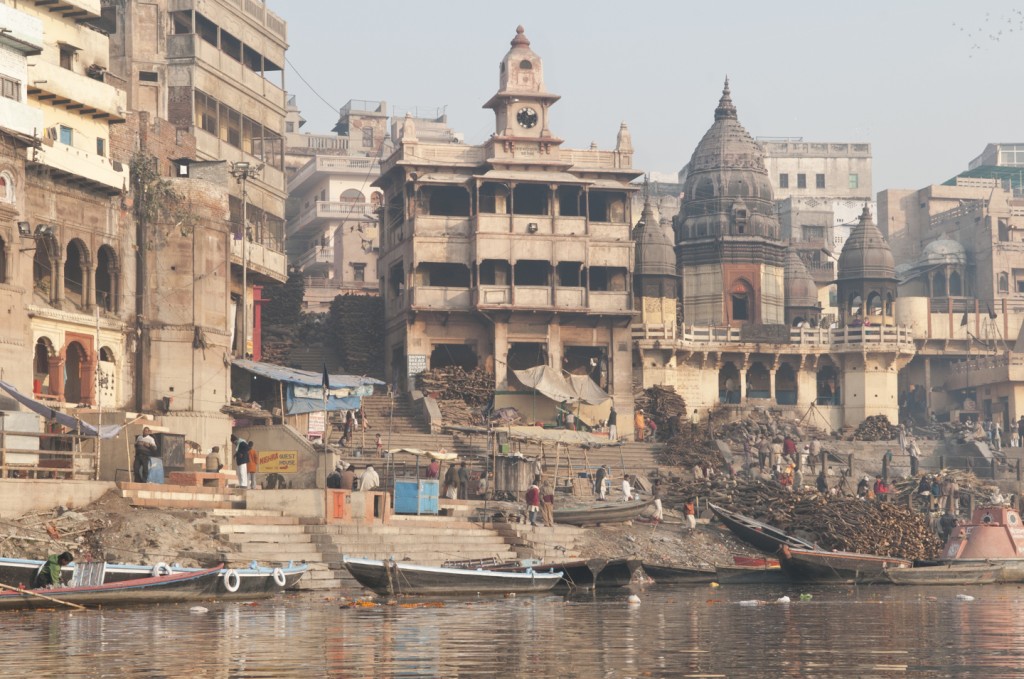
Varanasi & The Ganges River – India. Photo courtesy of Paul Cohn, www.paulcohnimages.com
So in Varanasi, don’t do as the Romans do and bathe in the Ganges River. The likelihood of contracting one of many widespread airborne and waterborne illnesses is astoundingly high. Be very wary of the water here, and with what you eat – raw vegetables washed in the water will make you sick. A National Institute of Health survey of residents who bathed and used water from the Ganges reported that 66% contracted waterborne diseases over the course of one year; cases of cholera, dysentery, typhoid, hepatitis-A, and gastrointestinal disease were all reported. Put simply, be aware.
* * *
Our first experience in this famous pilgrimage destination is not a positive one, and we start the day by getting ripped off by the train ticket clerk when booking our train to the border of Nepal. After we tell him which train we want and pay for it, he books us the wrong tickets for the wrong day. Not knowing this until he gives us the tickets and sends us off do we realize. Within 10 minutes, we’re back at his desk. He cancels our tickets and tells us the tickets we need are sold out…and then charges us a 25% cancellation fee. Yes, for the wrong tickets that he booked, he charges us to refund them. And so the ups and downs of Varanasi begin.
We search in vain for a hotel – Scindia House – that I’m now fairly sure does not exist. We check out one place with a lovely garden but the room has a depressing and strange vibe. No. The driver takes us to what he misunderstood as being Scindia House: Sandhya Guest House. (In case you’re wondering its location in Varanasi, just refer to their business card: “Next Door Shivala Post Office”…you won’t find a street address!)
Arriving and realizing this is not the right hotel, we decide to look at the rooms anyway. It’s actually pretty decent and in the middle of town, and another slight improvement over the last hotel in Agra. A better bathroom and a small balcony, the room overlooks the holy ghats of the Ganges River. It’s runs us about $8 per night, so really, no complaints here. In India, things just tend to work out.
It’s time to visit these ghats everyone raves about. I have to admit, I just don’t see it. Old sets of steps disappear right into the filthy water of the Ganges, and children splash and swim in it without a care in the world. As the idea of contracting dysentery or cholera does not appeal to either of us, we decide against dipping our feet in and instead get a bite to eat. Chloë, in her months away from the U.S., is craving pizza. One random turn along a path reveals a pizzeria sign with an arrow. First pizza place we encounter on the entire trip. Thanks, Universe.
I kind of wish we hadn’t found it. And by ‘kind of,’ I mean ‘really.’ Aside from the fact that Indian pizza tastes nothing like Italian or New York pizza, our al fresco dining has invited even more flies in our food, on our hands – flying onto a slice as I eat it. What little appetite I have vanishes halfway into the meal. And I’m pretty sure this is the meal that gets Chloë sick; but more on that later.
Since we had gotten ripped off earlier at the train station, and still had no tickets to leave the country the day Chloë’s visa required her to, we needed to figure out an alternative to get to Nepal. And shortly into our walk around the city after lunch, wondering where we should go, we see a sign: Tiwari Tours & Travel. Again, thanks, Universe!
Crossing the threshold of the office, I quickly conclude that everything about this place is awesome. We follow the Indian custom of removing our shoes at the door. While the only man working wraps up a phone call, he gestures for us to sit. Gladly! I plunk down on a white-sheeted mat and lean against a pillow along the wall. With a deep sigh of relief, I realize why I feel so comfortable: I look up and see the cool air condition circulating, and most delightfully, I notice there are no flies. The swooshing and swatting had ceased. It’s like when your hiccups finally stop, or your eye stops twitching: it’s a reprieve from an absolute nuisance.
Once off the phone, Praveen in his loose linen attire sashays over to us barefoot and gracefully sits on the mat opposite me. If anyone could embody yoga, Yanni, and spiritual meditation, it would be Praveen. A guru of travel, he helps us get the tickets we need. Another phone call and suddenly tickets on the elusive, sold-out train were now available. For the cost that is double the original fare. SOLD. I don’t mind this because, frankly, we’re now talking about $5.00 instead of $2.50. Yes, definitely sold. Skeptical at how easy this was? Yes. Much choice? No. We are asked to pay for the tickets now, even though there are no tickets. “You come back tomorrow after 12:00pm and I have them for you.” Great, we just have to find our way back…
* * *
As sunset approaches, we’re compelled to return to the Ganges River. Chloë wants to take a boat ride to see the evening ceremonies along the banks, as do I; but more importantly, I want to take part in the ages-old tradition of lighting candles and sending them off into the river. With each candle lit, I will say a prayer for my parents and give thanks for their love; there will be a candle for Tommy, my muse whose love has awakened my soul, and a candle for his sister Coleen, who is bravely battling leukemia.
So picture this: as the sun begins to set, we push off from the dock in our boat, and I light each candle with thoughts of loved ones. Gently, carefully, I set the little leaf cups one by one – each with a candle surrounded by yellow and purple carnations – into the water, giving every one a little kiss as I do it. They float off together, drifting away quietly into the sunset, awaiting answers from the gods. Then we row on, easing to a stop at the ceremonies, and watch these deeply rooted rituals take place. Beautiful, isn’t it?
That’s not at all how it happens.
After bickering and arguing with what I can only conclude are the laziest boatmen this side of the world, we finally settle on a 400-rupee price to take us for one hour around to see the ceremonies. We had been told previously that we should expect to pay 400 rupees for two hours; the boatmen wanted to charge 800 rupees for that time. A lot of work rowing two people, they say. What they don’t say is that they’re going to bring along a half dozen of their lazy friends who have no intention of rowing. We’re the ones causing a lot of work? I don’t think so. But we’re in the boat and pushing off when they jump in – not much we can say.
Out into the river, I insist we pause to send off my candles. Although it’s darker out than I had envisioned and the photo ops are gone, I am happy to finally send off the delicate candle diyas. Our boatful of people remain quiet, and I say an individual prayer as I had wanted. The ritual is very cool, and the moment quite special, beyond what I would have thought. To be there, in one of the greatest holy places of the Hindu faith, acting out a Hindu tradition, I somehow feel that my prayers have a bit more impact.
With the last candle send off, I turn back to Chloë and the boatmen. We start moving again – one man rows while the others lounge. It’s painfully slow. No wonder it takes two hours to go ½ kilometer and back. One man points out the “monuments” – sorry, but the city water tower and a run-down property that will someday become a hotel don’t count.
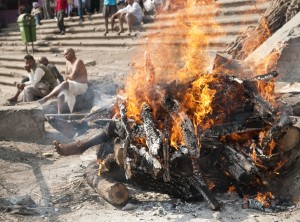
Burning ritual in Varanasi – India. Photo courtesy of Paul Cohn, www.paulcohnimages.com
There’s a burning ceremony coming up to our left, and we stop and see burning corpses piled high over several fire pits, tended by children. I can safely say, never in my life have I seen anything remotely like this in person. It’s fascinating yet horrific; though it’s still something I do not need to see again. After five minutes, Chloë and I are ready to see the main ceremonial show that everyone goes to see. Now, trapped in the middle of a toxic river, we’re told, “No – that will cost more.” This is not what we agreed upon, and the arguing begins all over again. They aren’t taking us anywhere until we give them more money, and our arguing gets louder. I feel like we’re hostages who have to pay our own ransom; we’re outnumbered greatly, and the harassment is nothing short of threatening. But finally, begrudgingly, they back off, and take us to the ceremony.
Chloë and I get off the boat to join the audience, and decide right then and there that we’re not getting back on it. One man keeps a close eye on us, and as we walk away, he blocks our path. “Where are you going?” We tell him point blank, “We’re leaving. Because of your lies, your threats, your bullshit – we’re done here.” “You have to pay,” he says. “Fine – we took half the trip. We’ll pay half.”
And then the problems really start.
The remaining boatmen come after us yelling and arguing that we owe them the full amount. Meanwhile, our own crowd is gathering around us as we yell back at the first guy. The shouting continues. Now, midway through this, I realize we’re arguing over a sum in the neighborhood of $4.
But we’ve had it – we have reached our fill of extortion, being ripped off, lied to, and cheated in the last 12 hours. It was the principle of it now, and albeit stubbornly, neither of us will back down. I cut them off and say, “200 rupees. Take it or leave it.” The first guy responds, “I don’t even want your money. You’re a bad person. Very bad people.” Both Chloë and I flare back in unison, “FINE!” Spinning on our heels, we storm off.
They let us – for a minute – and then the second boatman runs up to us and says, “Okay, 300.” Chloë turns and yells, “NO! Here – that’s it.” She gives him the 200. They finally leave us alone. I am thankful we didn’t get arrested. Still, Chloë and I are both rattled and shaken. We clear our heads and know that we better get a rickshaw back to our hotel so those deadbeat men can’t follow us.
If only that had been the end of our night.
* * *
Suddenly, in an instant, Chloë turns her head and cries out, “Oh my god, SHIT! A bug just flew in my ear! Oh my god, GET IT OUT!!!” Uh oh. “Come here in the light… Chloë, I can’t see anything.” This is not good. The bug that flew in her ear is too far in to pull out even with tweezers, which I don’t have anyway. She shakes her head frantically, smacking the opposite side to try to jostle it out. Nothing. Panicked and with a fear of bugs, she keeps telling me she can feel it crawling around.
It’s 8:30pm, and it’s dark. Scrambling with no clue where a hospital or doctor is, we need to find a pharmacy – surely someone working there will know what to do. “This is karma for not paying them!” she cries. “NO IT’S NOT! Those men were awful. They lied to us, tried to intimidate us into paying them more money when we’re trapped and stuck on a boat at their mercy with nowhere to go. This is NOT karma. They didn’t deserve a dime, let alone half.”
Chloë’s nightmare continues. For every second this bug is in her ear, her fear and paranoia is multiplying. I am unable to calm her. In finding a pharmacy, no one senses the blatant urgency of the situation – there is no rush, on par with most of India. After several minutes of waiting, I buy eardrops, and the pharmacist directs me to administer two drops into her ear, which will force the bug out. I tear the seal and unscrew the bottle. “Tilt your head to the side – I need to get these drops to stay in.” We do this, but nothing happens. I do it again; still nothing. We need a doctor. With what seems like another 20 agonizing minutes, I get a name of a doctor from the pharmacist, along with an address. It’s across town. Our only option to get there is a bicycle rickshaw, and on the ride over I desperately try to soothe my friend. “You said it feels big – your ear canal narrows and is blocked by your ear drum – the bug has nowhere to go and it can’t get into your body. It’ll be okay.” No idea if this is really helping.
Finally we reach a four-story strip mall complex where a couple of loitering kids lead us to the doctor’s office noted on the pharmacist’s sheet of paper in my hand. Now 9:00pm, the office is closed. “WHAT?!” Chloë is in utter despair. One of the kids, completely unaware of the problem, advises, “Come back Monday.” That, clearly, is not an option. “Where’s a doctor that’s open?!” she asks. They shrug. We walk away, unsure of our next plan. As we do, Chloë suddenly sees an office with lights on. The door’s unlocked and she rushes in. “Hello? Are you a doctor?” A man alone in his office sitting behind a desk of course says, “Yes.” He’s probably an accountant or something. She tells him about the bug – “Can you get it out?” and I tell him what the pharmacist gave us and what he advised us to do – and that it hadn’t worked.
He gestures for her to sit down and again tilt her head. The neighborhood kids and I both watch intently as he takes the eardrop bottle and jams it in her ear, and squeezes half of the bottle’s contents into it. He keeps her head tilted, only letting her straighten it after a minute. Within another 30 seconds, Chloë freaks out all over again, more frantic and scared than before. The bug is moving more fiercely than ever. Chloë jumps up, shakes her head and shouts, “It’s coming out!” …And onto the floor falls a flying insect a full inch in length.
The doctor charged her 50 rupees – about a $1 – for what seemed like saving her life.
* * *
That night, Chloë’s health begins to deteriorate. She wakes with a fever and chills, and her stomach cramps so badly that she buckles over and curls up in pain. She struggles to get to the bathroom, and everything in her system comes out both ends. This goes on for hours, and into the next day. At best, she fears she has Delhi Belly – the gastrointestinal illness that plagues millions of tourists and locals alike from ingesting contaminated food and water. At worst, it could be anything – malaria a likely culprit; but only time would tell.
“You’re going to have to go back for the tickets. I can’t leave,” she says. I look at her knowing she’s right and not going anywhere. Her pallor frightens me, but so does the idea of venturing out alone. Up until this point, she has led the way, and I’ve been happy to tag along for the ride. I hadn’t even paid attention to where we were going or where we had been, because I followed her lead. But I keep this to myself.
“No problem! Stay and rest. Can I bring you anything – more water, some Indian Pepto, food?” When I say food, I think she’s going to be sick all over again. “…Sorry.”
“Maybe a Sprite or 7up…and something for my stomach. I’ll pay you back.” That’s the least of my worries. “Okay, I’ll be back as soon as I can.” With a fresh application of bug spray, I grab my hat and step out into the city.
Deep breath. I start off this little adventure in the entirely wrong direction. Adding to the fact that there are very few street signs and major roads to get your bearings, the travel office had been an accidental find. We had only stumbled upon it after wandering left and right, back and forth, and stopping for lunch. These detours have thrown me to say the least. After walking the equivalent of three New York City blocks, I realize that what I saw yesterday is not what I’m seeing today. Crap.
I head back to the front of the hotel, and start again. A young Indian girl, about 14, with a timeless beauty and gentle eyes that seemed to reveal a wise and old soul stops me and asks if I am lost. Remembering the other times people have offered to help, and then wanted money, I reply, “No, I’m fine, thanks.” My hesitation is evident. “I can help you. Where are you trying to go?” she asks. “Oh some ticket office – I can find it.” If I’m lucky. I’m still skeptical to ask for help, and she clearly reads my mind. “It’s okay, I’m not looking for money.” Check mate. I can’t help but let down my guard. “Okay, I’m trying to find this travel agency.” I show her the business card Praveen had given me. She thinks for a moment and looks in both directions, not sure. “I think I know, but let me ask.”
She walks up to a man in a nearby stall selling metalware and exotic, colorful glass lanterns. Her words are in Hindi. They converse for several minutes – which I’ll never pretend I can translate – and they wrap up with his pointing in the opposite direction I had been heading. She concurs, and turns to me. “Yes, you go that way to the next road and turn left. Follow that around toward the water. Then I believe you turn right. And it should be close.” Their directions jog my memory. I am so grateful for their help, and I thank them both profusely. It’s the first time someone helps me that didn’t want money in return. She smiles and says, “Not everyone wants something.”
I find the travel shop with ease. Once again I remove my shoes, and greet Praveen at the door. The tickets are ready. Success! I double-check the date, time, locations, and sleeper class – two uppers this time. I go over with him where we need to go and transfer, and what we need to do. My brain still has a hard time remembering Indian and Hindi names so I write them all down. I ask Praveen, “So we’re riding the train to Gorakhpur, taking a bus from there to Sonali, walking from Sonali to cross the border into Nepal, and then taking a bus to Kathmandu. Do you have an idea of how long this entire trip might be?”
Thoughtfully, he replies, “Almost a day.” 24 hours?! It’s only 300 miles! *This is where Stephanie forgets she’s going from one third-world region to another third-world region…through >MOUNTAINS<*
“Anything faster?” I ask. He nods. “A flight – that would run about 10,000 rupees ($200). Or a taxi; it would cost…about 11,000 rupees ($220).” Hmm…vs. a $5 train ticket plus $10 more for buses. Chloë wouldn’t go for it, despite her health. No way to reach her to check either. Train, bus, and rickshaw trip it will be.
Hesitantly, I add, “Could you help me with one more question?” He smiles, “Yes?” I continue. “My friend who was with me yesterday is really sick – we think it was something she ate. Do you know what she should take for that?” He knows this illness well. “Ah, yes. Pudin Hara.” Puda what? “Pudin Hara. It’s a little green bottle, about 30 rupees (60¢!). It’s toxic, so use just a little bit. And you must add water. Dilute it.” You lost me at ‘toxic.’ “She’ll be okay. A pharmacist, ask him for antibiotics also; he’ll know what to give you.” It was a wealth of information that I knew I could trust. With a great deal of thanks, it’s back out into the flies and the heat of Varanasi.

Pudin Hara, courtesy of www.mail.coimbatore.com
On my way back while looking for a pharmacy stall – here, these are all outside stalls like the fruit stands, jewelers, and other merchant goods – I find myself a follower. His name is Suni, and he likes my hat. Everyone likes my hat in this country! We chat for a bit, which I love. Interacting with the locals is my favorite part of traveling (the boatmen experience excluded…); something Chloë had understandably become a bit jaded by throughout her travels. But on my own, I can do that more.
As we walk, we pass a temple which I ask Suni about. There are dozens, he says. He’s happy to show me then and there, but I tell him maybe later because I need to get medicine for my sick friend. He’s even more excited now than he was about the temples. “I know a good pharmacy! My friend, he works there.” And to the pharmacy we go.
I pick up a very small, very green bottle of Pudin Hara, and the pharmacist advises me on the dilution ratio. I also ask what else can cure my friend’s stomach. He gives me antibiotics as well while catching up with Suni. The total cost? 99 rupees. Or, about $2.00. I thank Suni and head back to check on Chloë, grabbing a bottle of Sprite on the way. Her words sum up how she’s feeling: “Worst day EVER.”
Quite proud of my independent self, I tell her, “You don’t have to worry about anything else – I got our tickets, and I have medicine for you. And a soda.” I explain which medicine is which and the dosage of each, and the toxicity of Pudin Hara. Pouring about a teaspoon of the Pudin Hara in her water bottle, I hand it to her. I conclude it must taste wretched from her facial expression. “Sorry.” I wish I could do more.
“I need to lie down,” she says. In our small room, I don’t want to disturb her. I ask if she’d be okay for a couple of hours – I needed to get something to eat and wanted to wander a bit – but then I’d be back. She likes the plan.
* * *
I head downstairs across the street to my first solo meal. At Chatni Restaurant, I order Tandoori Chicken and na’an, choices I’ve come to feel are safe as far as Delhi Belly is concerned. It’s a spot catering to tourists – not usually my style – but it’s outside, shaded and airy, and the powerful, giant turbo fans keep the flies away. It’s the perfect spot to eat a late lunch and catch up on my journal book.
Books! Speaking of books! This reminds me that it’s our last day in India and I have not yet gotten the book I wanted to buy, The Glass Palace, by Amitav Ghosh. Very fond of books, I thought it fitting to bring one back that was well received and written by an Indian author. But where is a bookstore that would carry it? I hadn’t seen many booksellers in India. No Starbucks, either; but that’s another story. Without much of a plan, I finish lunch and wander a bit more. I’ll head over to the temples and see just what exactly my new buddy Suni was talking about.
And what do you know – as I make my way over to that same part of town, around the corner he appears, arms outstretched and smiling instantly. “Hey!” It’s funny to see a local as a familiar face. We catch up with each other’s day, and I ask where these temples are that he’d mentioned earlier. “I will show you!” …After seeing four and realizing that as a non-Hindu white person, I’m not allowed in them, the interest admittedly wears off.
So I figure I would throw it out there. “Do you know of any good book stores?” … “YES!” He knows of a great one that has everything. I’m surprised but know he hasn’t steered me wrong yet.
This mini-journey with my new friend Suni actually becomes the most interesting adventure of this trip. As we walk, he points out sights that would otherwise go unnoticed. Right next to us, two men carry a mound of bright fabric on a slab with handles – “There’s a body to be cremated.” I never would have realized this on my own; at a glance it was fabric, but up close, it was the outline of a corpse. He gestures to a group of people in rags where all of the children stand barefoot in the dirt road – “the low caste” he says with a great deal of nonchalance. I get a sense that for some in the higher castes, this is just how it is. There’s no sense of superiority from Suni; right or wrong, it’s just a cultural system in place that goes back thousands of years.
Along the way, we pick up Suni’s friend, Mangolis, who works with Suni at a silk design shop. Together, the three of us head away from town, through more markets, dirt roads, and overall chaos. As I begin to wonder if this bookstore exists, we reach an intersection where, I recall quite vividly, traffic is going in six different directions. Rickshaws, cars, mopeds, pedicabs…and us. Do I really want to go to this bookstore? My new friends help me through it, walking on either side of me, and with one close call by a distracted driver, we survive our little game of Chicken and keep walking. Crossing onto a much quieter street, we reach an unmarked building. “We are here!” Suni is quite delighted with himself. Uh…where?
I open the front door into a foyer of greenery and lush plants, and a trickling waterfall in the corner. Up a few steps past this little rainforest, I am transported to a haven of knowledge – through another door to two stories of wall-to-wall books, the second floor a narrow walkway and railing open to an information counter at the center below. Suni tells me to take my time – they’ll gladly wait.
Now on a quest to find The Glass Palace, I can’t help but take in all of the oddities and little surprises this bookstore holds. In one corner, I see a shrine with a holy water pond and statuary; next to that, a sign pointing to the Antiquarian Books section (my favorite!); and near the back, I pass by the nicest bathroom I’d seen since setting foot in Asia, with candles, incense lit, Kleenex, soap, and the ever elusive toilet paper. But focusing on my book, I find the right section and climb a proper library ladder – I feel like I’m in Hogwarts or at the Trinity College library in Dublin – and reach up and grab it. Perfect!
As the day draws to a close, I know I need to part ways with my new friends soon. We step outside into a darkening sky as rain begins to fall. Far from where I met them and from my hotel, we hail a rickshaw and drive back in that direction.
Saying good-bye, I think what a pleasant surprise this random encounter turned out to be. I had been on my own that day, and I could have easily maintained my distance from the locals. But I never would have understood the temples, realized when corpses were being lugged alongside me, or known how the castes were perceived by natives. And I certainly never would have found the oasis of a bookstore tucked away hidden from tourists. Thanks to Suni and Mangolis, the day was priceless. As I write this, I raise a glass to them, and hope someday I can return the favor. I wonder if I’ll ever see them again.
I walk up the stairs back to our room, knowing very soon Chloë and I will be on our way once again to another adventure and another story. And if I’m lucky, I’ll meet more people like Suni, Mangolis, and the pretty girl who helped me find my way.





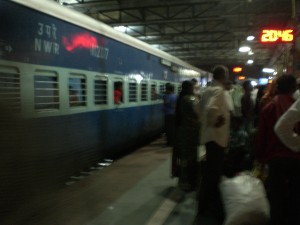
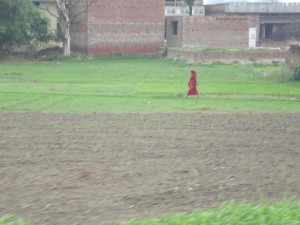
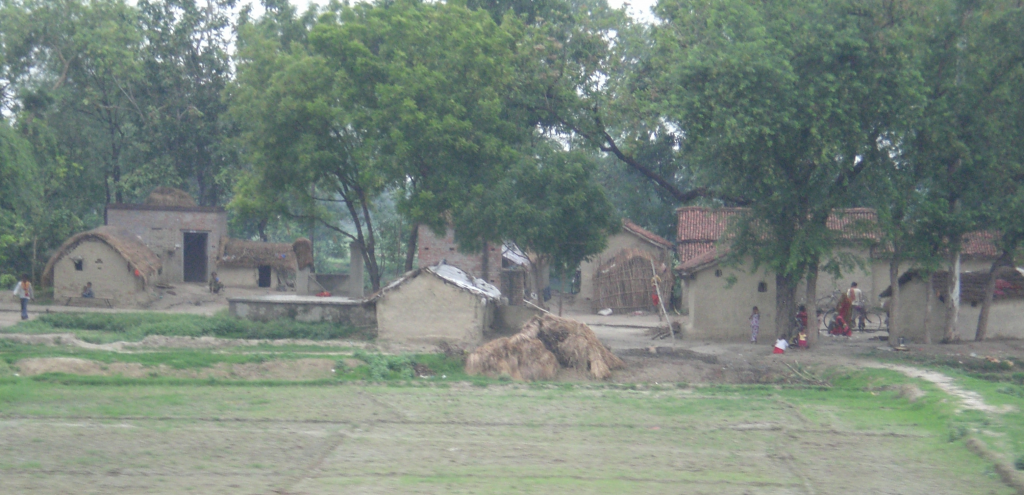
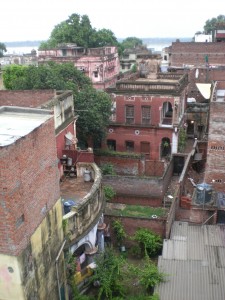
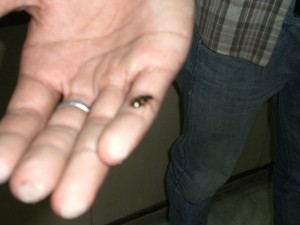
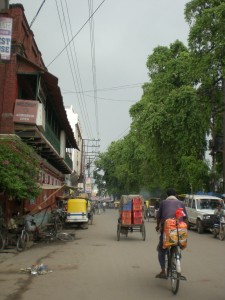
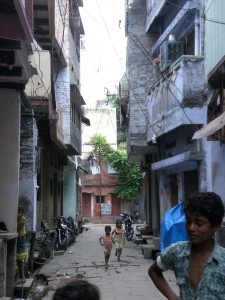
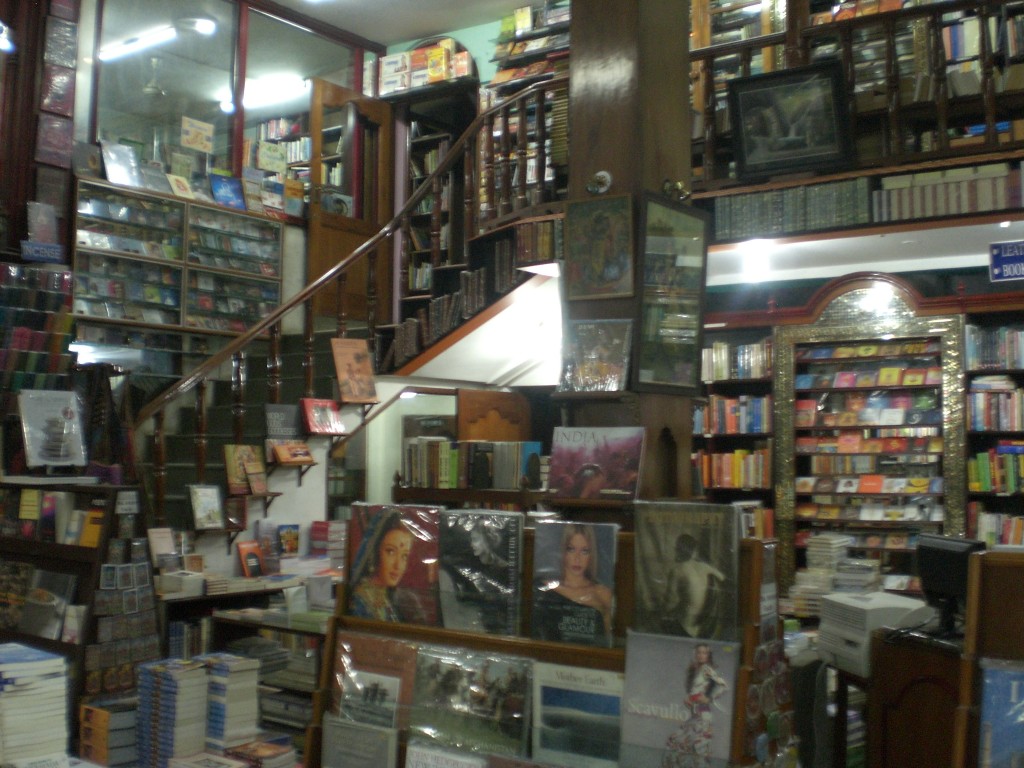
I enjoyed reading your accounts very much. At eighty five, it’s unlikely I’ll ever set foot on Indian soil. Paul Cohn is my nephew and I do look forward to meeting with him and Abby real soon.
My very best to you on your journey.
Sylvia Jaffe
I am so moved by your beautiful series on India. I was particularily touched by the candle ceremony on the river. How very kind and sweet of you to light candles for your loved ones, especially your boyfriend’s sister, Coleen. I hope she is recovering, and I wish her good health.
Looking forward to your next travel article. You are am amazing writer.